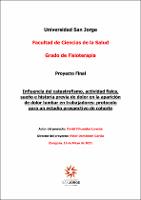Por favor, use este identificador para citar o enlazar este ítem:
https://repositorio.usj.es/handle/123456789/591
Registro completo de metadatos
| Campo DC | Valor | Lengua/Idioma |
|---|---|---|
| dc.contributor.advisor | Doménech-García, Víctor | - |
| dc.contributor.author | Villuendas Lorente, David | - |
| dc.date.accessioned | 2021-07-21T10:43:50Z | - |
| dc.date.available | 2021-07-21T10:43:50Z | - |
| dc.date.issued | 2021 | - |
| dc.date.submitted | 2021 | - |
| dc.identifier.uri | https://repositorio.usj.es/handle/123456789/591 | - |
| dc.description | Introduction: Low back pain (LBP) is the leading cause of disability in the world, affecting mainly the industrial working population. Although much research has been done on the characteristics that people with LBP have in common, more effort is still needed to understand the factors that predict LBP. Longitudinal studies in healthy working populations may be an initial step in solving this problem. Objective: To examine whether the baseline presence of psychosocial factors (catastrophizing), previous history of pain, low level of physical activity and poor sleep quality, as measured by online scales, has an effect on the occurrence of LBP in industrial workers observed over one year. Methods: It is a cohort study protocol (prospective, analytical and observational) in which 118 healthy industrial workers are recruited. For inclusion, the main characteristic is that participants do not have LBP and have not had it within one year. The duration of the study is 12 months and there are three important dates on which different variables are measured: Catastrophizing (Pain Catastrophizing Scale), physical activity level (International Physical Activity Questionnaire) and sleep quality (Medical Outcomes Study) are measured at baseline, 6 and 12 months. Previous history of pain (at baseline only) and LBP (at 6 and 12 months) will also be measured with the extended version of the Nordic Musculoskeletal Questionnaire. LBP intensity will be measured with the Numerical Pain Scale. Expected results: The variables analysed are expected to correlate with each other and have a strong relationship with the occurrence of LBP. Conclusion: This study may provide new insights into the relationship of certain factors with the occurrence of LBP in workers. However, future research will be needed to try to clarify which factors are most strongly related to LBP. | es_ES |
| dc.description.abstract | Introducción: El dolor lumbar (DL) es la principal causa de discapacidad en el mundo afectando sobre todo a población trabajadora de industria. Aunque se ha investigado mucho sobre las características que tienen en común las personas con DL, todavía se requieren más esfuerzos en conocer los factores que predicen el DL. Los estudios longitudinales en población sana trabajadora puede ser un paso inicial en resolver este problema. Objetivo: Examinar si la presencia inicial de factores psicosociales (catastrofismo), historia previa de dolor, bajo nivel de actividad física y mala calidad de sueño, medido mediante escalas online, tiene un efecto en la aparición de DL en trabajadores de industria observado durante un año. Métodos: Es un protocolo de un estudio de cohorte (prospectivo, analítico y observacional) en el cual se recluta a 118 trabajadores sanos de industria. Para la inclusión la principal característica es que los participantes no tengan DL ni hayan tenido en un año. La duración del estudio es de 12 meses y hay tres fechas importantes en las que se miden diferentes variables: Catastrofismo (Pain Catastrophizing Scale), nivel de actividad física (Cuestionario Internacional de Actividad Física) y calidad de sueño (Medical Outcomes Study) se miden al inicio, a los 6 y 12 meses. También se medirá la historia previa de dolor (sólo al inicio) y el DL (en el 6 y 12 mes) con la versión extendida del Cuestionario Nórdico Musculo-esquelético. La intensidad del DL se medirá con la Escala Numérica del Dolor. Resultados esperados: Se prevé que la historia previa de dolor, el catastrofismo y el nivel de actividad física sean los predictores que correlacionan más fuerte con la aparición del DL. Conclusión: Este estudio puede aportar nuevos conocimientos sobre la relación de determinados factores con la aparición de DL en trabajadores. Con todo ello, serán necesarias futuras investigaciones para tratar de esclarecer qué factores se relacionan con mayor fuerza con el DL | es_ES |
| dc.format.extent | 38 p. | es_ES |
| dc.format.mimetype | application/pdf | es_ES |
| dc.language.iso | spa | es_ES |
| dc.relation.requires | Requiere Adobe PDF | es_ES |
| dc.rights | Attribution-NonCommercial-NoDerivatives 4.0 Internacional | * |
| dc.rights.uri | http://creativecommons.org/licenses/by-nc-nd/4.0/ | * |
| dc.subject | Dolor Lumbar | es_ES |
| dc.subject | Catastrofismo | es_ES |
| dc.subject | Actividad Física | es_ES |
| dc.subject | Calidad de Sueño | es_ES |
| dc.subject | Historia Previa de Dolor | es_ES |
| dc.subject | Low Back Pain | es_ES |
| dc.subject | Catastrophizing | es_ES |
| dc.subject | Physical Activity | es_ES |
| dc.subject | Sleep Quality | es_ES |
| dc.subject | Previous History of Pain | es_ES |
| dc.title | Influencia del catastrofismo, actividad física, sueño e historia previa de dolor en la aparición de dolor lumbar en trabajadores: protocolo para un estudio prospectivo de cohorte | es_ES |
| dc.type | info:eu-repo/semantics/bachelorThesis | es_ES |
| dc.rights.accessrights | info:eu-repo/semantics/openAccess | es_ES |
| dc.contributor.affiliation | Universidad San Jorge | es_ES |
| Aparece en las colecciones: | Grado en Fisioterapia | |
Ficheros en este ítem:
| Fichero | Descripción | Tamaño | Formato | |
|---|---|---|---|---|
| Influencia del catastrofismo, actividad física, sueño e historia previa de dolor.pdf | 1,25 MB | Adobe PDF |  Visualizar/Abrir |
Este ítem está sujeto a una licencia Creative Commons Licencia Creative Commons

